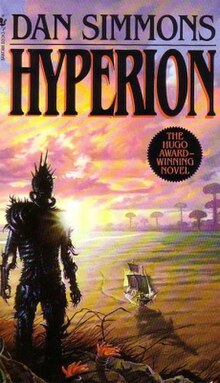
The Canterbury Tales is a collection of twenty-four stories that runs to over 17,000 lines written in Middle English by Geoffrey Chaucer between 1387 and 1400. It is widely regarded as Chaucer's magnum opus. The tales are presented as part of a story-telling contest by a group of pilgrims as they travel together from London to Canterbury to visit the shrine of Saint Thomas Becket at Canterbury Cathedral. The prize for this contest is a free meal at the Tabard Inn at Southwark on their return.
Dan Simmons is an American science fiction and horror writer. He is the author of the Hyperion Cantos and the Ilium/Olympos cycles, among other works which span the science fiction, horror, and fantasy genres, sometimes within a single novel. Simmons's genre-intermingling Song of Kali (1985) won the World Fantasy Award. He also writes mysteries and thrillers, some of which feature the continuing character Joe Kurtz.
A heroic couplet is a traditional form for English poetry, commonly used in epic and narrative poetry, and consisting of a rhyming pair of lines in iambic pentameter. Use of the heroic couplet was pioneered by Geoffrey Chaucer in the Legend of Good Women and the Canterbury Tales, and generally considered to have been perfected by John Dryden and Alexander Pope in the Restoration Age and early 18th century respectively.

John Keats was an English poet of the second generation of Romantic poets, along with Lord Byron and Percy Bysshe Shelley. His poems had been in publication for less than four years when he died of tuberculosis at the age of 25. They were indifferently received in his lifetime, but his fame grew rapidly after his death. By the end of the century, he was placed in the canon of English literature, strongly influencing many writers of the Pre-Raphaelite Brotherhood; the Encyclopædia Britannica of 1888 called one ode "one of the final masterpieces".
Lamia is a daemon in Greek mythology.
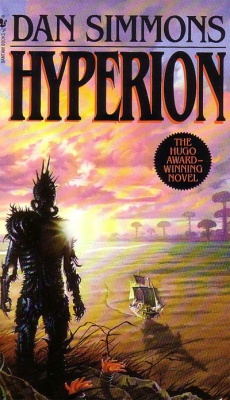
The Hyperion Cantos is a series of science fiction novels by Dan Simmons. The title was originally used for the collection of the first pair of books in the series, Hyperion and The Fall of Hyperion, and later came to refer to the overall storyline, including Endymion, The Rise of Endymion, and a number of short stories. More narrowly, inside the fictional storyline, after the first volume, the Hyperion Cantos is an epic poem written by the character Martin Silenus covering in verse form the events of the first two books.
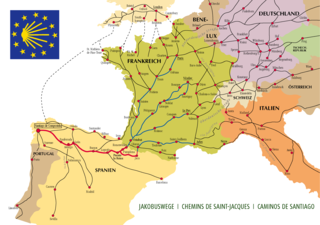
The Camino de Santiago, or in English the Way of St. James, is a network of pilgrims' ways or pilgrimages leading to the shrine of the apostle James in the cathedral of Santiago de Compostela in Galicia in northwestern Spain, where tradition holds that the remains of the apostle are buried.
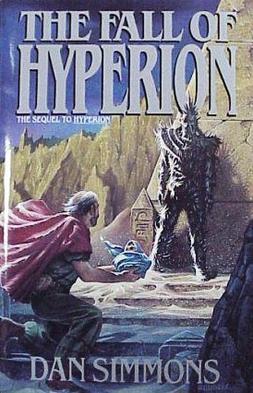
The Fall of Hyperion is the second novel in the Hyperion Cantos, a science fiction series by American author Dan Simmons. The novel, written in 1990, won both the 1991 British Science Fiction and Locus Awards. It was also nominated for the Hugo Award and the Nebula Award.

Sivagiri is an area in Varkala Municipality of Thiruvananthapuram district in Kerala. It is a pilgrimage centre of Varkala Town where the tomb, or samadhi, of Sree Narayana Guru is situated. It is a place where Guru built the Sarada Temple dedicated to Sarada Devi. The tomb is an attraction for thousands of devotees every year, especially during the Sivagiri Pilgrimage days from 30 December to 1 January.
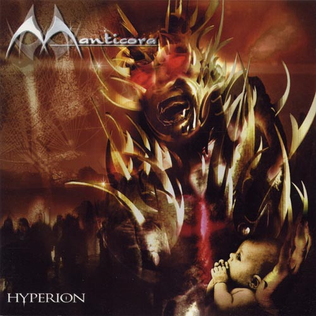
Hyperion is a concept album by Manticora, released in 2002.
"Orphans of the Helix" is a 46-page science fiction short story by American writer Dan Simmons, set in his Hyperion Cantos fictional universe. It was first published in the anthology Far Horizons in 1999.

Prayers to Broken Stones is a short story collection by American author Dan Simmons. It includes 13 of his earlier works, along with an introduction by Harlan Ellison in which the latter relates how he "discovered" Dan Simmons at the Colorado Mountain College's "Writers' Conference in the Rockies" in 1981. The title is a borrowed line from T. S. Eliot's "The Hollow Men".
Pantropy is a hypothetical process of space habitation or space colonization in which, rather than terraforming other planets or building space habitats suitable for human habitation, humans are modified to be able to thrive in the existing environment. The term was coined by science fiction author James Blish, who wrote a series of short stories based on the idea.

Endymion is the third science fiction novel by American writer Dan Simmons, first published in 1996. Part of his Hyperion Cantos fictional universe, it centers on the new characters Aenea and Raul Endymion, and was well received, like its predecessors Hyperion and The Fall of Hyperion. Within a year of its release, the paperback edition had gone through five reprints. The novel was shortlisted for the 1997 Locus Award.

Clarel: A Poem and Pilgrimage in the Holy Land is an epic poem by American writer Herman Melville, originally published in two volumes in 1876. It is a poetic fiction about a young American man named Clarel, on pilgrimage through the Holy Land with a cluster of companions who question each other as they pass through Biblical sites. Melville uses this situation to explore his own spiritual dilemma, his inability to either accept or reject inherited Christian doctrine in the face of Darwin's challenge, and to represent the general theological crisis in the Victorian era.
Ilium/Olympos is a series of two science fiction novels by Dan Simmons. The events are set in motion by beings who appear to be ancient Greek gods. Like Simmons' earlier series, the Hyperion Cantos, it is a form of "literary science fiction"; it relies heavily on intertextuality, in this case with Homer and Shakespeare as well as references to Marcel Proust's À la recherche du temps perdu and Vladimir Nabokov's novel Ada or Ardor: A Family Chronicle.
Daniel the Traveller, known also as Daniel the Pilgrim, Daniel of Kiev, or Abbot Daniel, was the first travel writer from the Kievan Rus. He is known for travelling to the Holy Land in the aftermath of the First Crusade and his descriptions are important records of the region during that time. Some have identified him with a certain Daniel, bishop of Yuryev between 1115 and 1122.

The Rise of Endymion is a 1997 science fiction novel by American writer Dan Simmons. It is the fourth and final novel in his Hyperion Cantos fictional universe. It won the Locus Award for Best Science Fiction Novel, and was nominated for the Hugo Award for Best Novel in 1998.

Vanni Fucci di Pistoia was a 13th-century Italian and a minor character in Inferno, the first part of Dante Alighieri's epic poem the Divine Comedy, appearing in Cantos XXIV & XXV. He was a thief who lived in Pistoia, as his name indicates; when he died, he was sent to the seventh bolgia of the eighth circle of Hell, where thieves are punished. In that bolgia, his punishment was to be stung by a serpent, reduced to ashes, and then restored to his former shape for more torturing. Dante and Virgil meet him and ask him why he was there. He replied that he stole a treasure from the Church of St. James in his hometown; he had wrongly accused an innocent man, Vanni della Nona, with the crime, for which della Nona was executed. Fucci says he was not caught but he still went to Hell. He then predicts the overthrow of the Florentine Whites to spite Dante and then insults God by making obscene gestures at him, and is attacked by numerous nearby serpents and by the monster Cacus, who was put in the bolgia for stealing Hercules's cattle.
Simon Emmanuel Jimenez is a Filipino-American writer of speculative fiction. His novels include The Vanished Birds and The Spear Cuts Through Water. Jimenez's works have received critical praise, with his debut novel being nominated for the 2021 Locus Award for Best First Novel and the 2021 Arthur C. Clarke Award. Jimenez himself was nominated for the 2021 Astounding Award for Best New Writer.
